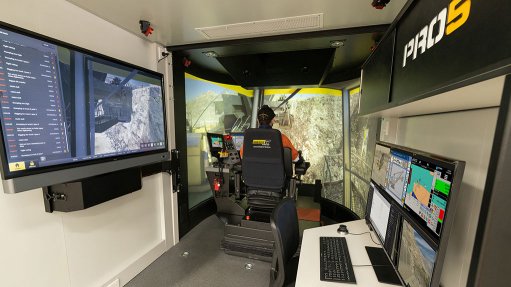AI, robotics play important role in demolition sector



KATE BESTER Jet Demolition project manager Kate Bester believes that remote-controlled demolition techniques will enhance safety
AUTOMATED DEMOLITION A crusher used by Jet Demolition to demolish a structure
Demolition robots are a relatively new form of professional service robot used in the demolition sector to demolish buildings at the end of their life cycle. These mobile robots leverage a range of end-of-arm tools such as buckets, breakers, crushers or drills to break through building materials, infrastructure demolition company Jet Demolition notes in a press release published earlier this year.
While demolition robots and remote demolition have been available for many years and demolition technology is advancing globally, which is having a positive impact on the local sector, Jet Demolition is circumspect in acknowledging that there are limitations to such technology.
For instance, remote-control units will be used “specifically where there is a risk of soil subsidence during sinkhole remediation. The machine operator can control the machine from a distance. However, there is a definite compromise on precision and reactivity,” says Jet Demolition contracts and project manager Kate Bester.
“For the most part, being able to read and assess a structure’s behaviour is paramount to the safety of the team, which is very difficult to do from a distance. For this reason, our use of remote-demolition practices is very restricted,” she highlights.
Oftentimes, remote-controlled techniques are reserved for instances where it simply is not practically possible to approach a structure safely using conventional demolition techniques, and a considered decision is made to approach the structure remotely, in the interest of safety.
Most demolition robots resemble small excavators, without the cab. They are designed to function effectively in constrained spaces and fit through doorways and stairways. Demolition robots occupy 90% of the total market for construction robots.
Moreover, they are one of the first commercially viable service robots to tackle applications in a traditionally labour-intensive industry. The value of the overall construction robot market was anticipated to be $321-million in 2022, with a global compound annual growth rate of 8.7% from 2016 to 2022.
In addition to demolition robots, autonomous mobile robots (AMRs) are one of the latest and most innovative automation solutions available. AMRs differ from automated guided vehicles (AGVs) by their degree of autonomy, with AMRs far more independent and adaptable than AGVs. They can navigate complex environments and avoid obstacles without the need for external guidance systems, adds Bester.
“Automating demolition is all about safety and efficiency,” she says, adding that it also has the potential to reduce costs for both demolition and construction companies.
Robotic automation places human workers out of harm’s way and allows them to be more productive. While the initial capital expenditure is high owing to it being a relatively new technology, the long-term return on investment and impact on health and safety more than offsets the cost, she avers.
“Our main concern is for the safety of people. Our methods, resources and approach are all aligned exactly to serve this purpose. We have been in business since 1994 and have kept our focus on the main objective of completing a project safely, on time, and to international standards,” she adds.
While Jet Demolition undertakes most types of demolition work, its preference is generally for a mechanical application as a ‘best possible’ approach. This is in accordance with international best practice. Jet Demolition has an extensive equipment fleet, giving it the flexibility to draw from within its own reserves to suit the method selected.
Comments
Press Office
Announcements
What's On
Subscribe to improve your user experience...
Option 1 (equivalent of R125 a month):
Receive a weekly copy of Creamer Media's Engineering News & Mining Weekly magazine
(print copy for those in South Africa and e-magazine for those outside of South Africa)
Receive daily email newsletters
Access to full search results
Access archive of magazine back copies
Access to Projects in Progress
Access to ONE Research Report of your choice in PDF format
Option 2 (equivalent of R375 a month):
All benefits from Option 1
PLUS
Access to Creamer Media's Research Channel Africa for ALL Research Reports, in PDF format, on various industrial and mining sectors
including Electricity; Water; Energy Transition; Hydrogen; Roads, Rail and Ports; Coal; Gold; Platinum; Battery Metals; etc.
Already a subscriber?
Forgotten your password?
Receive weekly copy of Creamer Media's Engineering News & Mining Weekly magazine (print copy for those in South Africa and e-magazine for those outside of South Africa)
➕
Recieve daily email newsletters
➕
Access to full search results
➕
Access archive of magazine back copies
➕
Access to Projects in Progress
➕
Access to ONE Research Report of your choice in PDF format
RESEARCH CHANNEL AFRICA
R4500 (equivalent of R375 a month)
SUBSCRIBEAll benefits from Option 1
➕
Access to Creamer Media's Research Channel Africa for ALL Research Reports on various industrial and mining sectors, in PDF format, including on:
Electricity
➕
Water
➕
Energy Transition
➕
Hydrogen
➕
Roads, Rail and Ports
➕
Coal
➕
Gold
➕
Platinum
➕
Battery Metals
➕
etc.
Receive all benefits from Option 1 or Option 2 delivered to numerous people at your company
➕
Multiple User names and Passwords for simultaneous log-ins
➕
Intranet integration access to all in your organisation

















